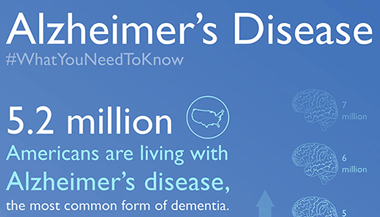Blood Pressure and Alzheimer's Risk: What's the Connection?
Something as simple as taking a drug that costs pennies a day could one day reduce your risk of Alzheimer’s disease . That’s the intriguing finding from a Johns Hopkins analysis of previously gathered data, which found that people who took commonly prescribed blood pressure medications were half as likely to develop Alzheimer’s as those who didn’t.
Researchers have known about the link between blood pressure and Alzheimer’s for years. In 2013, investigators showed that older people with high blood pressure, or hypertension , were more likely to have biomarkers of Alzheimer’s in their spinal fluid. Another study found that the more blood pressure varied over an eight-year period, the greater the risk of dementia .

Inside the Brain-Blood Pressure Link
What’s the connection? High blood pressure can damage small blood vessels in the brain, affecting parts of the brain responsible for thinking and memory. So can controlling blood pressure through medication also lower Alzheimer’s risk?
The recent Johns Hopkins report published in the journal Neurology confirmed earlier work from Johns Hopkins researchers that found the use of potassium-sparing diuretics reduced the risk of Alzheimer’s nearly 75 percent, while people who took any type of antihypertensive medication lowered their risk by about a third.
“What we found was that if you didn’t have Alzheimer’s and you were taking blood pressure medication, you were somewhat less likely to develop dementia. And if you had dementia from Alzheimer’s disease and you took certain antihypertensives, the disease was less likely to progress,” explains Constantine Lyketsos, M.D., director of the Memory and Alzheimer’s Treatment Center at Johns Hopkins. “It’s not clear if the connection comes from managing the blood pressure better or if the particular drugs might have properties that interfere with other processes relating to Alzheimer’s.” He says he suspects both play a role. Stay tuned for results of further research, but in the meantime, learn ways to manage your risk of hypertension.
Research Shows How Low Should You Go?
Lower is not necessarily better when it comes to blood pressure. A 2013 study published in the journal JAMA Neurology found that people with heart disease or stroke who had lower-than-normal blood pressure (in which the bottom, or diastolic, number was less than or equal to 70 mm Hg) were more likely to show changes in the brain that can affect cognition and memory. National guidelines recommend people with hypertension who are 60 and older aim for a goal of less than 150/90 mm Hg, while those ages 30 through 59 aim for a diastolic goal of less than 90 mm Hg. Younger people should aim for a goal of less than 140/90 mm Hg. Consult with your doctor about the best target for you.
Bring Down Blood Pressure Now
While more research investigates the brain benefits of blood pressure meds, you can play it smart by taking healthy lifestyle steps to keep blood pressure in a healthy range. Here are some of the best strategies.
Eat real.
That means nixing processed foods—even canned vegetables, which are often high in sodium. Among the most successful blood-pressure-lowering diets are a Mediterranean diet or DASH (Dietary Approaches to Stop Hypertension). Both diets are high in fruits, vegetables, whole grains , low-fat dairy, poultry, fish and nuts, but low in harmful fats, red meat, sweets and sugary drinks. The effects can be quick, with blood pressure reductions in just two weeks.
Shed extra weight.
In one analysis of 25 clinical trials, losing an average of 11 pounds shaved 4.4 points off systolic blood pressure (the top number) and 3.6 points off diastolic (the bottom number). Other studies have found that modest weight loss can prevent hypertension in overweight people, even if they don’t reduce the amount of sodium in their diet.
Check blood pressure at home.
Monitoring your blood pressure at home can improve blood pressure management more than just seeing your doctor. You can purchase automatic blood pressure cuffs for as little as $35; ask your doctor for a recommendation. Many pharmacies and drugstores also offer free blood pressure readings.
Definitions
Blood vessels (veh-suls): The system of flexible tubes—arteries, capillaries and veins—that carries blood through the body. Oxygen and nutrients are delivered by arteries to tiny, thin-walled capillaries that feed them to cells and pick up waste material, including carbon dioxide. Capillaries pass the waste to veins, which take the blood back to the heart and lungs, where carbon dioxide is let out through your breath as you exhale.
Dementia (di-men-sha): A loss of brain function that can be caused by a variety of disorders affecting the brain. Symptoms include forgetfulness, impaired thinking and judgment, personality changes, agitation and loss of emotional control. Alzheimer’s disease, Huntington’s disease and inadequate blood flow to the brain can all cause dementia. Most types of dementia are irreversible.
Diastolic (die-uh-stah-lick) blood pressure: The second, or bottom, number in a blood pressure reading. Diastolic blood pressure measures the force of blood in the arteries when the heart is relaxed between beats. A healthy reading is usually below 80 mm Hg. Higher readings may indicate that you have high blood pressure or are at risk for developing it.
Systolic (sis-tall-ick) blood pressure: The top, or first, number in a blood pressure reading. Systolic blood pressure is the pressure in the arteries during a heartbeat. For most people, a healthy systolic blood pressure reading is below 120 mm Hg. Rising systolic blood pressure may indicate that arteries are becoming stiff or that there’s a build-up of plaque.
Whole grains: Grains such as whole wheat, brown rice and barley still have their fiber-rich outer shell, called the bran, and inner germ. It provides vitamins, minerals and good fats. Choosing whole grain side dishes, cereals, breads and more may lower the risk for heart disease, type 2 diabetes and cancer and improve digestion, too.






